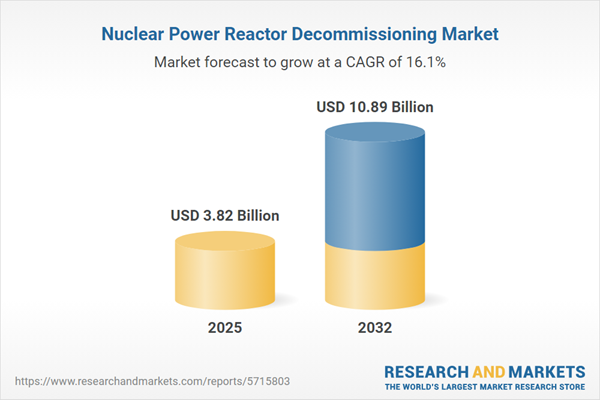Speak directly to the analyst to clarify any post sales queries you may have.
Senior decision-makers in the nuclear power reactor decommissioning market face a shifting landscape driven by regulatory complexity, rapid technology integration, and increasing demands for operational transparency. In this environment, informed market insights are essential to support safe, compliant, and future-ready project outcomes.
Nuclear Power Reactor Decommissioning Market Snapshot
The global nuclear power reactor decommissioning market is projected to grow from USD 3.30 billion in 2024 to USD 3.82 billion by 2025, achieving a 16.08% compound annual growth rate. This expansion is propelled by increased reactor retirements, evolving regulatory requirements, and a deepening focus on safety and environmental responsibilities. Companies are navigating these shifts with enhanced risk mitigation, advanced waste management adoption, and agile strategies aligned with national and regional policy directions. Reliable, data-driven market research enables organizations to address emerging risks, align with regulatory developments, and secure a position in a dynamic, cross-border marketplace.
Scope & Segmentation: Nuclear Power Reactor Decommissioning Market Intelligence
- Service Type: Dismantling and demolition require skilled teams and precision tools for safe decommissioning; advisory services help organizations achieve regulatory compliance and manage costs; site restoration covers both environmental remediation and redevelopment; waste management underpins the category with its emphasis on safe radioactive material handling and certified disposal practices.
- Project Phase: Typical activities include decontamination, removal of specialized equipment, close environmental monitoring, and final site restoration, all structured around rigorous process controls to protect the public and environment.
- Reactor Type: The market covers boiling water, gas-cooled, heavy water, fast breeder, and pressurized water reactors, each type presenting unique technical demands and strict regulatory mandates that shape the decommissioning approach.
- Waste Type: Strategies address the secure containment, transport, and certified disposal of high, intermediate, and low-level radioactive waste streams, all guided by international safety protocols.
- Ownership: Decommissioning projects overseen by government or private entities differ in procurement, transparency, and risk management approaches throughout the life cycle.
- Regional Coverage: The Americas, Europe, Asia-Pacific, and the Middle East & Africa each exhibit distinct policy frameworks; major markets such as the United States, Germany, India, China, Japan, the United Kingdom, and France drive specialized initiatives and regulatory priorities.
- Leading Companies Profiled: Key industry participants—including Jacobs Engineering Group Inc., Fluor Corporation, AECOM, Bechtel Corporation, SNC-Lavalin Group Inc., Tetra Tech, Inc., Orano SA, Westinghouse Electric Company LLC, Babcock International Group PLC, and Doosan Enerbility Co., Ltd.—offer comprehensive, regulatory-aligned services across all stages of the decommissioning value chain.
Key Takeaways for Senior Decision-Makers
- The integration of robotics, digital twin technology, and remote monitoring elevates safety standards and enables consistent, repeatable processes across complex project phases.
- Establishing collaborative, multi-stakeholder frameworks supports systematic risk identification and smooth project handovers between phases.
- Strategy adjustments are necessary to reflect the diverse regulatory and policy environments found in regions such as Europe, where harmonization efforts contrast with Asia-Pacific's segmented approaches.
- Early and sustained community engagement enhances legitimacy, reinforcing project momentum and helping to reduce delays arising from stakeholder uncertainty.
- Partnerships with skilled engineering and technology firms enable faster adoption of best practices and facilitate effective knowledge transfer within multidisciplinary teams.
Tariff Impact: Supply Chain and Cost Dynamics
Forthcoming US tariffs on nuclear decommissioning equipment and materials in 2025 are prompting organizations to reassess procurement and supply chain strategies. Measures include sourcing domestically, diversifying supplier bases, and renegotiating contract terms to better manage evolving risks. Investments in workforce development and cross-border collaboration are helping companies maintain project delivery and timeline certainty despite these new pressures.
Methodology & Data Sources
Findings are supported by direct interviews with sector leaders, reviews of the latest technical and regulatory documentation, and analysis of high-profile decommissioning projects globally. Segmentation is consistent with recognized best practices, supporting robust insights for procurement, project planning, and operational decision-making.
Why This Nuclear Power Reactor Decommissioning Market Report Matters
- Enables senior leaders to proactively navigate regulatory shifts and embed strong risk controls, assuring more strategic allocation of resources and consistent compliance outcomes.
- Presents benchmarks for procurement and execution models, assisting with the adoption of global best practices and improved supply chain efficiencies.
- Supports transparency initiatives and drives corporate sustainability efforts in line with stakeholder and public sector expectations.
Conclusion
Senior executives will find in this report the comprehensive context and actionable analysis needed to ensure compliance, manage project risk, and foster successful stakeholder collaboration in the nuclear power reactor decommissioning market.
Additional Product Information:
- Purchase of this report includes 1 year online access with quarterly updates.
- This report can be updated on request. Please contact our Customer Experience team using the Ask a Question widget on our website.
Table of Contents
3. Executive Summary
4. Market Overview
7. Cumulative Impact of Artificial Intelligence 2025
Companies Mentioned
The companies profiled in this Nuclear Power Reactor Decommissioning market report include:- Jacobs Engineering Group Inc.
- Fluor Corporation
- AECOM
- Bechtel Corporation
- SNC-Lavalin Group Inc.
- Tetra Tech, Inc.
- Orano SA
- Westinghouse Electric Company LLC
- Babcock International Group PLC
- Doosan Enerbility Co., Ltd.
Table Information
| Report Attribute | Details |
|---|---|
| No. of Pages | 186 |
| Published | October 2025 |
| Forecast Period | 2025 - 2032 |
| Estimated Market Value ( USD | $ 3.82 Billion |
| Forecasted Market Value ( USD | $ 10.89 Billion |
| Compound Annual Growth Rate | 16.0% |
| Regions Covered | Global |
| No. of Companies Mentioned | 11 |









